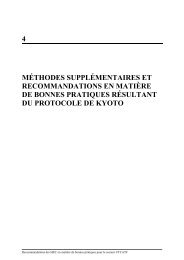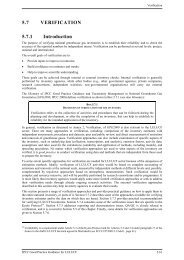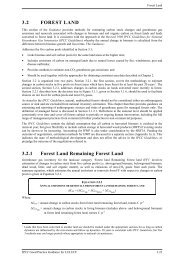Use of Models and Facility-Level Data in Greenhouse Gas Inventories
Use of Models and Facility-Level Data in Greenhouse Gas Inventories
Use of Models and Facility-Level Data in Greenhouse Gas Inventories
Create successful ePaper yourself
Turn your PDF publications into a flip-book with our unique Google optimized e-Paper software.
<strong>Use</strong> <strong>of</strong> <strong>Models</strong> <strong>and</strong> <strong>Facility</strong>-<strong>Level</strong> <strong>Data</strong> <strong>in</strong> <strong>Greenhouse</strong> <strong>Gas</strong> <strong>Inventories</strong><br />
Annex 1 shows CITL data; this conta<strong>in</strong>s verified emissions from each <strong>in</strong>stallation. The CITL data alone will not provide<br />
enough data for the GHG <strong>in</strong>ventory compilers. Annex 2 has an example <strong>of</strong> the detailed returns that a ref<strong>in</strong>ery,<br />
participat<strong>in</strong>g <strong>in</strong> the UK ETS, makes to the UK Environment Agency. These detailed returns provide a much richer source<br />
<strong>of</strong> data for <strong>in</strong>ventory compilers, <strong>and</strong> <strong>in</strong>clude <strong>in</strong>formation about the complexity (Tier) <strong>of</strong> the method used to estimate the<br />
emissions, the fuel consumptions, their carbon contents, calorific values <strong>and</strong> oxidation factors. Information about carbon<br />
contents is particularly valuable as <strong>in</strong> many cases operators have detailed fuel quality analytical programmes <strong>in</strong> place<br />
<strong>and</strong> hence the carbon contents are known very accurately. There is also some <strong>in</strong>formation about the processes at the<br />
report<strong>in</strong>g site; for example “flare1”, which presumably would mean a flare at the ref<strong>in</strong>ery, <strong>and</strong> “RFG” which means a<br />
process us<strong>in</strong>g ref<strong>in</strong>ery fuel gas 10 .<br />
Annex 3 has an example <strong>of</strong> the detailed ETS data that the UK GHG <strong>in</strong>ventory team is now able to access which is<br />
supplied from a database that the UK Environment Agency ma<strong>in</strong>ta<strong>in</strong>s <strong>in</strong> its role as the ETS regulator. Us<strong>in</strong>g this<br />
example, below is a commentary on the <strong>in</strong>formation that the data can provide to the UK GHG <strong>in</strong>ventory:<br />
• FuelType Some <strong>of</strong> the fuel nomenclature is clear, <strong>and</strong> identify<strong>in</strong>g some <strong>of</strong> the fuels is easy, for example<br />
RFG (OPG). The identities <strong>of</strong> other fuels need be guessed, for example GO - maybe gas oil? The composition<br />
<strong>of</strong> some fuels is unclear, for example F13.<br />
• ActivityTier / Activity<strong>Data</strong> No Tier <strong>in</strong>formation is provided for some records, but <strong>in</strong> most cases this<br />
affects only the smaller levels <strong>of</strong> activities (fuel consumption). The GHG <strong>in</strong>ventory team can analyse the Tier<br />
<strong>in</strong>formation reported to provide an <strong>in</strong>dication <strong>of</strong> the accuracy <strong>of</strong> the estimate.<br />
• NCV<strong>Data</strong> Net Calorific data. This field has provided a secondary means to identify fuel type as the<br />
GHG <strong>in</strong>ventory compilers can make an assumption <strong>of</strong> the type <strong>of</strong> fuel from its NCV.<br />
• EF<strong>Data</strong> / EFTier Emission Factor data. Emissions factors are mostly Tier 3, <strong>and</strong> this implies high accuracy.<br />
The UK GHG <strong>in</strong>ventory now uses some carbon emission factor data from the ETS to improve the accuracy <strong>of</strong> the GHG<br />
emissions. For example, the carbon emission factors from coal use <strong>in</strong> power stations are now taken from the ETS<br />
returns, as all the UK coal burn<strong>in</strong>g power stations report their carbon contents <strong>of</strong> coal us<strong>in</strong>g a Tier 3 methodology, <strong>and</strong><br />
these data are updated annually.<br />
For sources such as power stations, <strong>of</strong>ficial energy statistics are likely to be good, <strong>and</strong> so ETS data can ma<strong>in</strong>ly help to<br />
improve emission factors. In the case <strong>of</strong> carbon from catalytic crackers, <strong>of</strong>ficial energy statistics are likely to be based on<br />
estimates. For ETS report<strong>in</strong>g, carbon emissions are directly measured from crackers. Us<strong>in</strong>g ETS data for this source <strong>in</strong><br />
the UK GHG <strong>in</strong>ventory reduces the uncerta<strong>in</strong>ty both from the activity data <strong>and</strong> the emission factors used <strong>in</strong> the <strong>in</strong>ventory.<br />
The examples above show that for many sectors GHG <strong>in</strong>ventory emission estimates can only be compared with other<br />
source data at an aggregated level, comb<strong>in</strong><strong>in</strong>g both multiple sites <strong>and</strong> multiple emission sources. The <strong>in</strong>dividual<br />
<strong>in</strong>stallation data given <strong>in</strong> most <strong>of</strong> the data sets must always be aggregated up before comparison with GHG <strong>in</strong>ventory<br />
data. In some cases, multiple source categories <strong>in</strong> the GHG <strong>in</strong>ventory must also be aggregated to make a comparison<br />
possible. For example, <strong>in</strong> the cement sector, GHG <strong>in</strong>ventory estimates <strong>of</strong> CO 2 emissions from fuel combustion must be<br />
summed with estimates <strong>of</strong> GHG <strong>in</strong>ventory estimates <strong>of</strong> CO 2 emissions from the decarbonisation <strong>of</strong> limestone before they<br />
can be compared aga<strong>in</strong>st the sum <strong>of</strong> emissions reported for the entire cement sector.<br />
The publically available ETS data, accessible via the CITL, is <strong>of</strong> very limited use to the compilers <strong>of</strong> GHG <strong>in</strong>ventories.<br />
Inventory compilers need to ga<strong>in</strong> access to the more detailed data that is available to the <strong>in</strong>-country regulators <strong>of</strong> the<br />
ETS. This detailed data will conta<strong>in</strong> <strong>in</strong>formation that will help <strong>in</strong> the compilation <strong>of</strong> the GHG <strong>in</strong>ventory, <strong>and</strong> will <strong>in</strong>clude<br />
estimates <strong>of</strong> emissions, fuel use, <strong>and</strong> carbon emission factors. It is important to consider the Tier that has been used;<br />
the higher Tier data is the most valuable. Just because data is reported <strong>in</strong> the ETS does not imply that it is immediately<br />
suitable for use <strong>in</strong> a national GHG <strong>in</strong>ventory.<br />
1.3.2 Report<strong>in</strong>g coverage <strong>of</strong> <strong>in</strong>stallations across an economic sector<br />
The analysis Section 1.3.1 has shown that it is necessary to aggregate up the <strong>in</strong>stallation-level data <strong>in</strong> many data sets<br />
before they can be used <strong>in</strong> the GHG <strong>in</strong>ventory, or <strong>in</strong> an analysis <strong>of</strong> the differences between estimates <strong>of</strong> emissions <strong>in</strong> the<br />
10 RFG is derived from the crude oil distillation process <strong>and</strong> is used to fuel boilers, heaters, turb<strong>in</strong>es, etc. RFG is also used<br />
as a chemical feedstock (hydrogen source) <strong>in</strong> some ref<strong>in</strong>ery hydrogen plants. Ref<strong>in</strong>ery fuel gas composition may vary significantly on<br />
relatively short time scales; thus measurements <strong>of</strong> calorific values <strong>and</strong> carbon contents must be made at appropriate sampl<strong>in</strong>g<br />
locations <strong>and</strong> at sufficiently short time <strong>in</strong>tervals to accurately determ<strong>in</strong>e GHG emissions from the combustion.<br />
IPCC Expert Meet<strong>in</strong>g Report 74 TFI

















